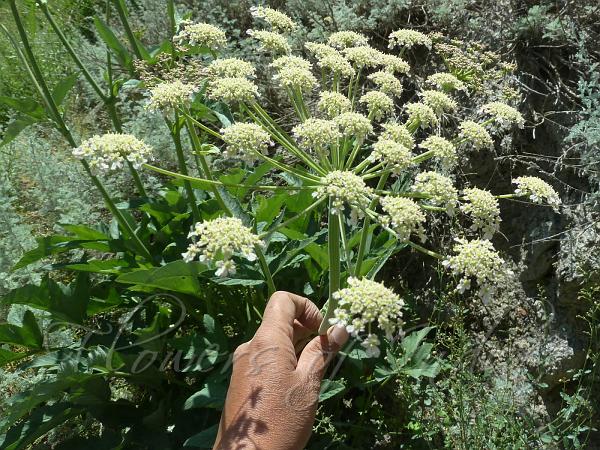|
| White Himalayan Hogweed |
|

|

| File size | 746428 |
| Original date | 6/22/15 11:55 AM |
| Resolution | 2560 x 1920 |
| Flash | Flash did not fire, auto |
| Focal length | 4.1mm |
| Exposure time | 1/400s |
| Aperture | 4.0 |
| Focus Distance | |
| Metering Mode | Multi-segment |
| Camera make | Panasonic |
| Camera model | DMC-TZ10 |
| Sensor type | OneChipColorArea |
|
|
|
|
Photo: |
Botanical name: Heracleum candicans Family: Apiaceae (Carrot family)
Synonyms: Heracleum cinereum, Heracleum hypoleucum
Synonyms: Heracleum cinereum, Heracleum hypoleucum
White Himalayan Hogweed is a plant 0.4-1 m tall,
velvet-hairy or woolly. Stem is solitary, branched. Basal and lower
leaves are pinnate; pinnae 2-3 pairs, ovate-oblong, 5-7 x 3-5 cm,
pinnately divided, below silvery, densely white woolly, margins
sawtoothed, tip with a short sharp point or blunt. Upper leaves are
reduced, stalkless, 3-lobed on expanded sheaths. Flower-cluster-stalks
are 15-30 cm, velvet-hairy; bracts 1-3, linear, falling off; rays
15-25, unequal, 3-7 cm, velvet-hairy; bracteoles 5-8, linear;
umbellules 20-25-flowered. Sepal-cup teeth are minute. Petals are
white, outer flowers of umbels radiant. Fruit is obovoid, 5-8 x 4-6 mm,
hairless when mature; vittae solitary in each furrow, 2 on commissure,
club-shaped, extending to 2/3 length of mericarp. White Himalayan
Hogweed is found in N. Pakistan to Himalaya and China, at altitudes of
1800-4500 m. Flowering: May-July.
Medicinal uses: The natives use its root paste
for skin disease, eczema and itches and relieving from joint pain.
Amchis (traditional
herbal doctors) of Ladakh region use its roots
for liver complaints, arthritis and toothache. Amchis of Nepal use
this plant in curing phlegm, earache, stomach disorders, infection,
bleeding, leprosy, fever due to wounds and blood pressure. The roots
contain coumarin. The plant powder is given in giddiness in Malanis
peoples of Kullu district, Himachal Pradesh. Seeds are orally given in
abdominal, colic, other digestive and flatulence complaints. Its fruits
are used as spice or flavouring agent in cooking.
The natives use its root paste
for skin disease, eczema and itches and relieving from joint pain.
Amchis (traditional
herbal doctors) of Ladakh region use its roots
for liver complaints, arthritis and toothache. Amchis of Nepal use
this plant in curing phlegm, earache, stomach disorders, infection,
bleeding, leprosy, fever due to wounds and blood pressure. The roots
contain coumarin. The plant powder is given in giddiness in Malanis
peoples of Kullu district, Himachal Pradesh. Seeds are orally given in
abdominal, colic, other digestive and flatulence complaints. Its fruits
are used as spice or flavouring agent in cooking.
Medicinal uses:
 The natives use its root paste
for skin disease, eczema and itches and relieving from joint pain.
Amchis (traditional
herbal doctors) of Ladakh region use its roots
for liver complaints, arthritis and toothache. Amchis of Nepal use
this plant in curing phlegm, earache, stomach disorders, infection,
bleeding, leprosy, fever due to wounds and blood pressure. The roots
contain coumarin. The plant powder is given in giddiness in Malanis
peoples of Kullu district, Himachal Pradesh. Seeds are orally given in
abdominal, colic, other digestive and flatulence complaints. Its fruits
are used as spice or flavouring agent in cooking.
The natives use its root paste
for skin disease, eczema and itches and relieving from joint pain.
Amchis (traditional
herbal doctors) of Ladakh region use its roots
for liver complaints, arthritis and toothache. Amchis of Nepal use
this plant in curing phlegm, earache, stomach disorders, infection,
bleeding, leprosy, fever due to wounds and blood pressure. The roots
contain coumarin. The plant powder is given in giddiness in Malanis
peoples of Kullu district, Himachal Pradesh. Seeds are orally given in
abdominal, colic, other digestive and flatulence complaints. Its fruits
are used as spice or flavouring agent in cooking. | Identification credit: Tabish | Photographed in Lahaul Valley, Himachal Pradesh. |
• Is this flower misidentified? If yes,